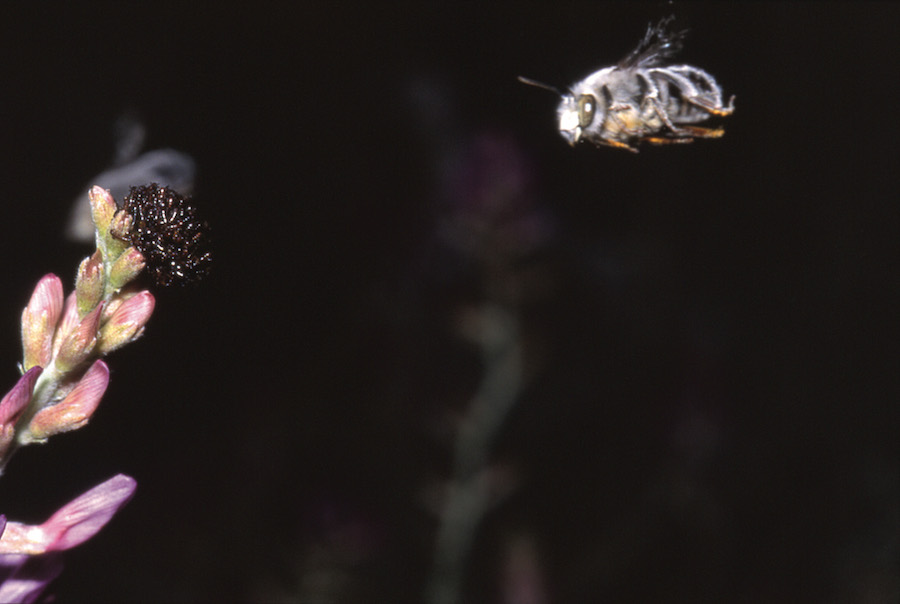
Parasitic blister beetle larvae exploit the sex pheromones of their host bee species and reap benefits
Abandoned by their parents on a blade of grass in the sand dunes, parasitic blister beetle larvae cluster together after hatching and laying dormant for an entire winter. Spring has come, and their chances of survival depend on their ability to secure a ride to a local bee nest, where there will be abundant bee eggs, nectar and pollen for feeding. The larvae resort to deception, emitting chemosensory signals that mimic the sex pheromones of female bees in a sly attempt to attract male bees to the aggregation. Once contact occurs, the larvae attach to the male bees and eventually to female bees through various acts of mating. Oblivious to the inevitable devastation of their home and young, the female bees transport the larvae to their nest.
The beetle larvae, M. Franciscanus, managed to pull off this complicated and deceitful stunt through the process of local adaptation. According to research lead by evolutionary ecologist Leslie Saul-Gershenz, the pheromones emitted by M. Franciscanus are blends of various compounds that are specialized to mimic the reproductive signals of their local bee species. The investigation included a series of transplant experiments that examined the interaction between the parasitic larvae and different host species, Habropoda pallida from California’s Mojave Desert and H. miserabilis from the coastal dunes of Oregon.
“Take an organism from its original location and move it to another location in a caged environment and compare it to the local organism,” Saul-Gershenz said. “We brought the larvae from the Oregon population to the Mojave desert because we wanted to see if the Habropoda pallida bees were attracted to them and vice versa, the larvae from the Mojave Desert were brought to Oregon to see if Habropoda miserabilis was attracted to them.”
In each geographic location, the host species significantly preferred local aggregations relative to the aggregations from a different geographic location. By becoming adept at tailoring its chemical signals and perching height to those of its host species, the parasitic larvae were able to target and attract the bees in its geographic location.
While not exactly what one would consider an honest living, similar examples of local adaptation can be observed in other species. For instance, the bolas spider shamelessly uses mimicry of pheromones of several moth species to lure its prey.
“This demonstrates that a single species can adapt and evolve in different ways depending on the local conditions,” said Jocelyn Millar, a chemical ecologist and a distinguished professor in the entomology and chemistry departments at UC Riverside. “Here, we showed that two different and isolated populations of the same meloid beetle species had evolved to adapt themselves optimally, in terms of both their behavior and the chemical signals that they were using to attract their hosts, to the two different bee species that were present in their local habitats in Oregon coastal sand dunes or the southern California desert respectively.”
Using electroantennography and complex chemical analysis, chemical ecologists Jocelyn Millar and Steve McElfresh were able to synthetically reconstruct the chemical components of the pheromones.
“Basically, what we looked for were compounds that were present in extracts from both the female bees, and from the beetle larvae, because we knew that the beetle larvae were mimicking the attractant from the female bees,” Millar said. “We then reconstructed that blend of compounds from synthesized chemicals.”
The knowledge from this research gives insight into interactions between species in ecosystems that are similar to this parasite-insect interaction and can be beneficial when trying to conserve a particular species.
“It is hard to envision a scenario where the bee perishes and the beetle doesn’t disappear along with it,” said Steven McElfresh of UC Riverside. “It shows that when we protect a single species we may in fact be protecting many species which depend upon it.”
One obvious question may still be lingering in the minds of readers: if the male bees can clearly see that the aggregations are not female bees, why are they not able to evade this deception?
“For this particular mating system, olfaction is more important than vision,” Saul-Gershenz said. “Mimicking a subset of the female pheromones is very important.”
Written by: Harnoor Gill— science@theaggie.org



